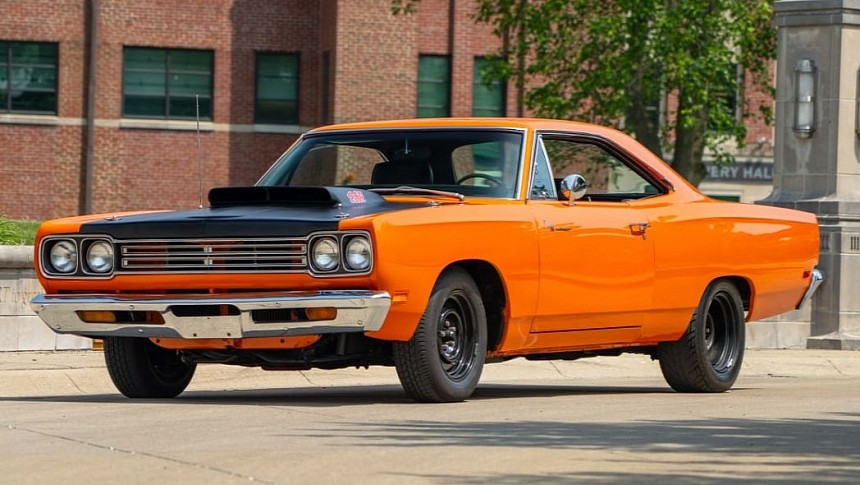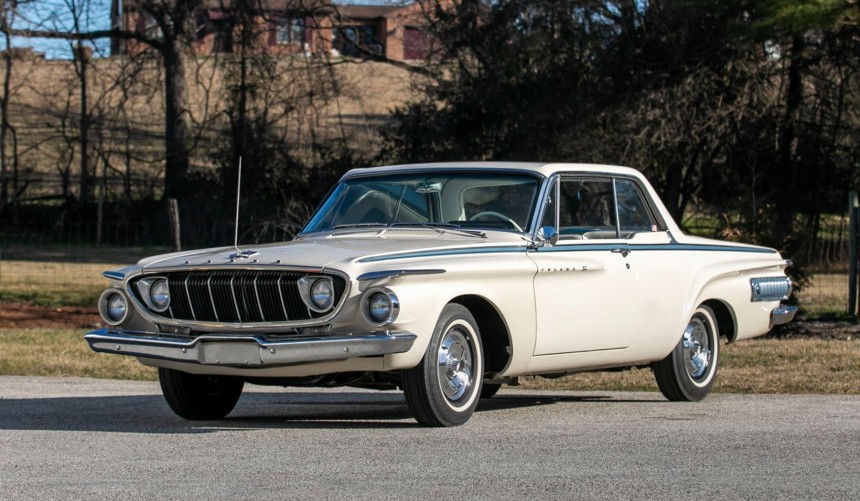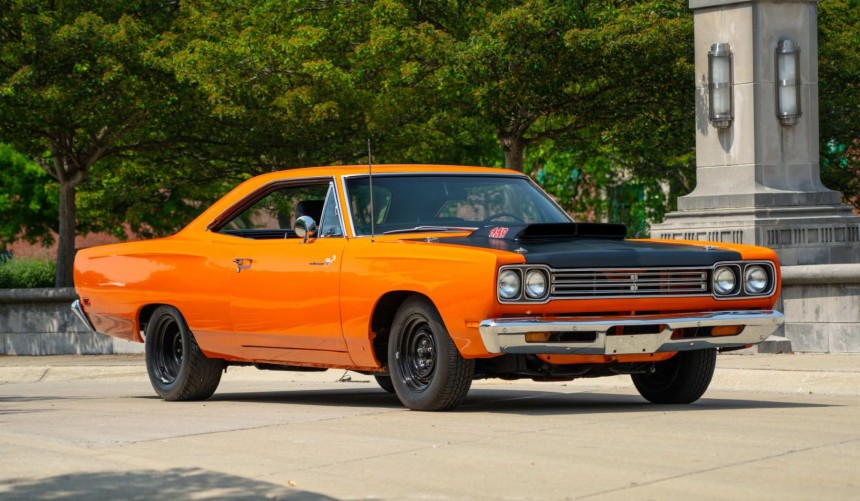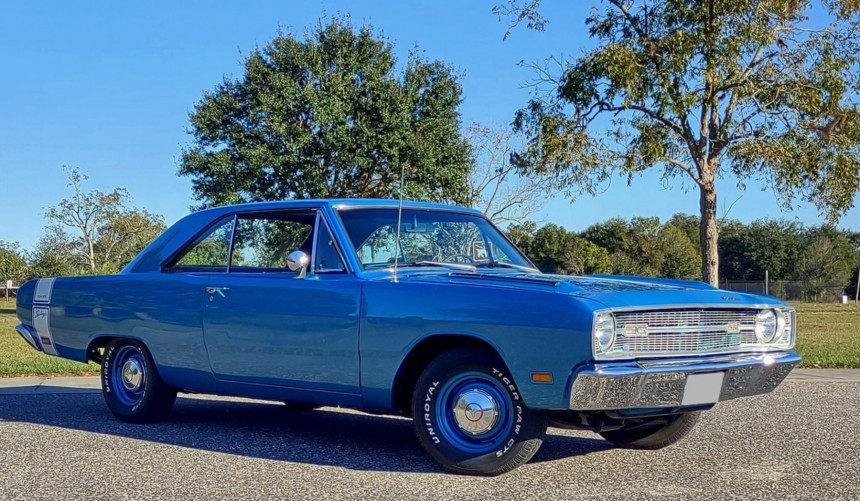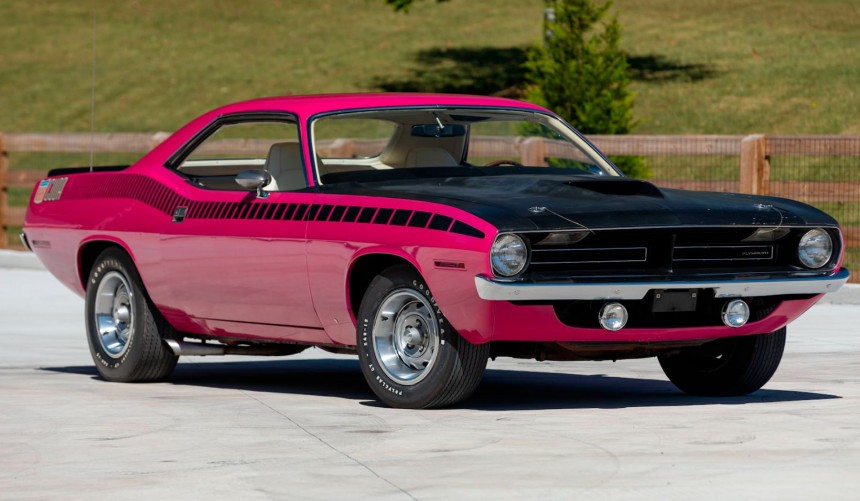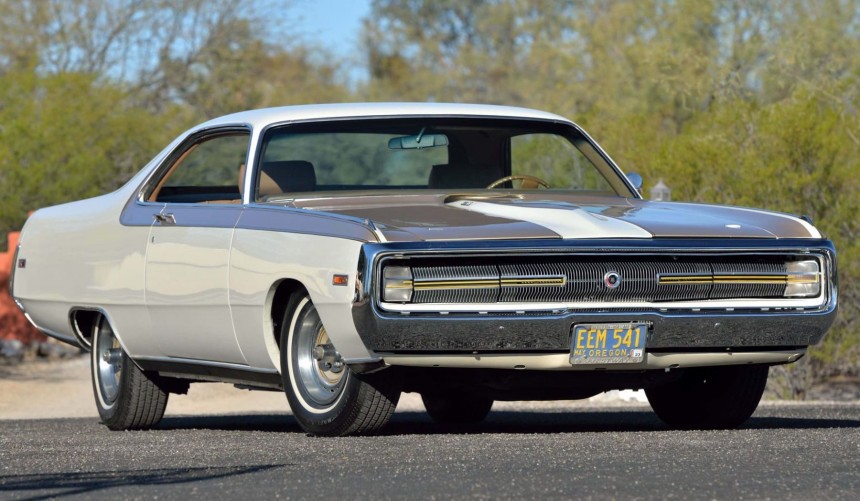During the short-lived golden age of muscle cars, high-powered Mopars ruled the roads and the drag strips. Though many hid the legendary Elephant engine under their hoods, some became icons with different high-performance engines.
Initially a NASCAR-bound engine, the 426 HEMI made its way to road-legal Dodges and Plymouths starting with the 1966 model year.
From that point on, HEMI-powered Mopars became the apex predators of the muscle car food chain, with few rivaling models able to outperform them.
From the mid-1960s to 1971, the HEMI was an option for all Dodge and Plymouth models with muscle car aspirations.
Nevertheless, thanks to other high-performance V8s, several Mopars, like the five featured in this article, made the proverbial muscle car Hall of Fame without HEMI power.
Two years before Pontiac introduced the trend-setting GTO and four years before the debut of the street HEMI, Chrysler developed a high-performance version of the 413-ci (6.7-liter) RB-block V8.
Called Maximum Performance Wedge and marketed as either Ramcharger 413 (Dodge) or Super Stock 413 (Plymouth), the Max Wedge was a drag-strip-oriented option on 1962 B-body intermediates like the Dodge Polara.
With 415 or 420 hp on tap (depending on the compression ratio), the engine turned the sporty, two-door Polara 500 into a muscle car sleeper.
I say "sleeper" because this performance package didn't add any visual enhancements that made the Polara 500 stand out from its siblings.
For the 1963 model year, the wheelbase was increased to 119 inches (3,023 mm), and the Max Wedge was bored out to 426 ci (7.0 liters), which pushed output to 415 or 425 hp (again, depending on the compression ratio)
Besides that, the 1963-1964 Dodge Polara 500 Max Wedge continued to look like a standard Polara, but in a straight line, no factory-built, street-legal intermediate could keep up.
Though the Max Wedge was a drag strip-oriented option offered by select dealers to buyers with a racing background, the Polara 500 and its Plymouth Super Sport sibling were technically road-legal.
As the muscle car craze was nearing its peak, Plymouth and Dodge added an affordable performance intermediate to their respective line-ups for the 1968 model year.
Though nearly identical to the Dodge Super Bee, the Belvedere-based Plymouth Road Runner became far more popular.
Initially available with either a standard performance-oriented version of the 383 cu in (6.3-liter) V8 or the optional (and expensive) HEMI, the Road Runner received a middle-ground engine option in the second part of the 1969 model year.
Dubbed 440 Six BBL (or 440 Six-Pack for Dodges), the new engine made 390 hp courtesy of a trio of two-barrel Holley carburetors. Even better, it was nearly twice as cheap as the HEMI option.
Apart from the terrific engine, the 1969 Road Runner 440 Six BBL was available with a unique matte-black fiberglass lift-off hood, a HEMI-grade suspension, and a Dana 60 rear axle with a 4:10 gearing.
Though not as fast as a HEMI-powered intermediate, the 1969 Plymouth Road Runner 440 Six BBL could embarrass most high-performance models from Chrysler's rivals.
While Plymouth's Road Runner became an epic sales success, Dodge's Super Bee didn't meet expectations. Nonetheless, the division didn't give up on the budget-friendly muscle car recipe, using it on the 1969 Dart.
Advertised with the slogan "6,000 RPM for under three grand", the 1969 Dart Swinger 340 was as basic as the compact could get in terms of styling and amenities.
But, while the small Swinger didn't impress with its looks, it more than lived up to the advertising slogan in terms of performance.
Under its hood, Dodge mounted the high-performance 340-ci (5.5-liter) small block that featured components like a hot camshaft, a forged crankshaft, heavy-duty conrods, and forged pistons.
Previously available in the more expensive Dart GTS, the high-performance engine was rated at 275 hp.
However, the output was deliberately underrated to keep insurance premiums at bay, and according to independent dyno tests, the lightweight V8 could make close to 350 hp.
Apart from the engine, the 1969 Dart Swinger 340 also came with a heavy-duty suspension, a limited-slip diff, and either a bombproof four-speed manual or a TorqueFlite automatic.
When equipped with the optional HEMI, the restyled 1970 Plymouth Barracuda was one of the quickest street-legal cars in the US at the time of its introduction.
But, since the third-gen Barracuda was available with plenty of powerful V8s, the HEMI-powered version wasn't the only 'Cuda-based Mopar muscle car legend introduced in 1970.
Introduced in March of 1970, the AAR 'Cuda was a conceived to homologate Dan Gurney's All American Racers (AAR) Barracudas for the SCCA Trans-Am series.
Power came from a 340-ci (5.5-liter) with special iron heads, solid lifters, and three two-barrel Holley carbs mounted on top of an Edelbrock aluminum intake.
The small block was rated at 290 hp, but like all other Mopar performance V8s of the era, the figure was lower on paper than out on the street.
The AAR 'Cuda was also given an eye-poping appearance package that mixed Plymouth's flashy, "high-impact" colors with matte-black accents.
The distinctive appearance package also contained a bespoke ducktail spoiler and was the first Detroit-built production car to feature staggered wheel sizes.
Though I could've completed this list with one of the numerous Plymouth or Dodges powered by something like the 440 Magnum, for variety's sake, I chose to add the only Chrysler of the era with real muscle car aspirations.
Based on the two-door coupe version of the 300 non-letter series, the land yacht was the largest vehicle we can now call a classic muscle car.
Developed with the legendary aftermarket shifter manufacturer turned performance consultant, the 300 Hurst received a bespoke two-tone paint job, a new fiberglass scooped hood, and a rear spoiler made from the same material.
Apart from the unique styling cues, the 300 H further distanced itself from the regular 300 with a standard 440-ci (7.2-liter) TNT V8.
Rated at 377 hp, the TNT was nothing more than a rebadged 440 Magnum that could enable the two-ton monster to accelerate from 0 to 60 mph (97 kph) in a respectable 7.1 seconds.
To help make the car more controllable, Chrysler also fitted it with a heavy-duty suspension comprised of bulkier rear leaf springs and front torsion bars.
From that point on, HEMI-powered Mopars became the apex predators of the muscle car food chain, with few rivaling models able to outperform them.
From the mid-1960s to 1971, the HEMI was an option for all Dodge and Plymouth models with muscle car aspirations.
Nevertheless, thanks to other high-performance V8s, several Mopars, like the five featured in this article, made the proverbial muscle car Hall of Fame without HEMI power.
1963 Dodge Polara 500 Max Wedge
Called Maximum Performance Wedge and marketed as either Ramcharger 413 (Dodge) or Super Stock 413 (Plymouth), the Max Wedge was a drag-strip-oriented option on 1962 B-body intermediates like the Dodge Polara.
With 415 or 420 hp on tap (depending on the compression ratio), the engine turned the sporty, two-door Polara 500 into a muscle car sleeper.
I say "sleeper" because this performance package didn't add any visual enhancements that made the Polara 500 stand out from its siblings.
For the 1963 model year, the wheelbase was increased to 119 inches (3,023 mm), and the Max Wedge was bored out to 426 ci (7.0 liters), which pushed output to 415 or 425 hp (again, depending on the compression ratio)
Besides that, the 1963-1964 Dodge Polara 500 Max Wedge continued to look like a standard Polara, but in a straight line, no factory-built, street-legal intermediate could keep up.
Though the Max Wedge was a drag strip-oriented option offered by select dealers to buyers with a racing background, the Polara 500 and its Plymouth Super Sport sibling were technically road-legal.
1969 Plymouth Road Runner 440 Six BBL
Though nearly identical to the Dodge Super Bee, the Belvedere-based Plymouth Road Runner became far more popular.
Initially available with either a standard performance-oriented version of the 383 cu in (6.3-liter) V8 or the optional (and expensive) HEMI, the Road Runner received a middle-ground engine option in the second part of the 1969 model year.
Dubbed 440 Six BBL (or 440 Six-Pack for Dodges), the new engine made 390 hp courtesy of a trio of two-barrel Holley carburetors. Even better, it was nearly twice as cheap as the HEMI option.
Apart from the terrific engine, the 1969 Road Runner 440 Six BBL was available with a unique matte-black fiberglass lift-off hood, a HEMI-grade suspension, and a Dana 60 rear axle with a 4:10 gearing.
Though not as fast as a HEMI-powered intermediate, the 1969 Plymouth Road Runner 440 Six BBL could embarrass most high-performance models from Chrysler's rivals.
1969 Dodge Dart Swinger 340
Advertised with the slogan "6,000 RPM for under three grand", the 1969 Dart Swinger 340 was as basic as the compact could get in terms of styling and amenities.
But, while the small Swinger didn't impress with its looks, it more than lived up to the advertising slogan in terms of performance.
Under its hood, Dodge mounted the high-performance 340-ci (5.5-liter) small block that featured components like a hot camshaft, a forged crankshaft, heavy-duty conrods, and forged pistons.
Previously available in the more expensive Dart GTS, the high-performance engine was rated at 275 hp.
However, the output was deliberately underrated to keep insurance premiums at bay, and according to independent dyno tests, the lightweight V8 could make close to 350 hp.
Apart from the engine, the 1969 Dart Swinger 340 also came with a heavy-duty suspension, a limited-slip diff, and either a bombproof four-speed manual or a TorqueFlite automatic.
1970 Plymouth AAR 'Cuda
But, since the third-gen Barracuda was available with plenty of powerful V8s, the HEMI-powered version wasn't the only 'Cuda-based Mopar muscle car legend introduced in 1970.
Introduced in March of 1970, the AAR 'Cuda was a conceived to homologate Dan Gurney's All American Racers (AAR) Barracudas for the SCCA Trans-Am series.
Power came from a 340-ci (5.5-liter) with special iron heads, solid lifters, and three two-barrel Holley carbs mounted on top of an Edelbrock aluminum intake.
The small block was rated at 290 hp, but like all other Mopar performance V8s of the era, the figure was lower on paper than out on the street.
The AAR 'Cuda was also given an eye-poping appearance package that mixed Plymouth's flashy, "high-impact" colors with matte-black accents.
The distinctive appearance package also contained a bespoke ducktail spoiler and was the first Detroit-built production car to feature staggered wheel sizes.
1970 Chrysler 300 Hurst
Based on the two-door coupe version of the 300 non-letter series, the land yacht was the largest vehicle we can now call a classic muscle car.
Developed with the legendary aftermarket shifter manufacturer turned performance consultant, the 300 Hurst received a bespoke two-tone paint job, a new fiberglass scooped hood, and a rear spoiler made from the same material.
Apart from the unique styling cues, the 300 H further distanced itself from the regular 300 with a standard 440-ci (7.2-liter) TNT V8.
Rated at 377 hp, the TNT was nothing more than a rebadged 440 Magnum that could enable the two-ton monster to accelerate from 0 to 60 mph (97 kph) in a respectable 7.1 seconds.
To help make the car more controllable, Chrysler also fitted it with a heavy-duty suspension comprised of bulkier rear leaf springs and front torsion bars.
